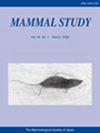Are Northeastern Forests of Bangladesh Empty? Insights from Camera-Trapping into Spatiotemporal Activity Pattern of Mammals in a Semi-Evergreen National Park
IF 0.8
4区 生物学
Q3 ZOOLOGY
引用次数: 2
Abstract
Abstract. Bangladesh holds 191 km2 semi-evergreen northeastern (NE) forests where systematic camera-trapping has never been carried out. An effort of 587 trap nights in Satchari National Park, a NE forest, revealed ten carnivores, two ungulates, two primates, two rodents, and one treeshrew (12 threatened in Bangladesh; of which three globally threatened; dhole and northern treeshrew were new discoveries). Pairwise circadian homogeneity, coefficient of temporal overlap ( ), and spatial cooccurrence pattern were measured. High values ( > 0.75) were noted in 36 pairwise comparisons, and positive spatial association (Pgt < 0.05) in five. Anthropogenic activities overlapped with diurnal species (0.65 ≤ 1 ≤ 0.88) but stood dissimilar (P < 0.05 in the Mardia-Watson-Wheeler test) except for yellow-throated marten–livestock movement (1 = 0.70). Although species-specific dietary or temporal preference explains the observed associations, low detection of the jungle cat (2) compared to the leopard cat (56), absence of the fishing cat, homogenous activity (P > 0.05) in yellow-throated marten–crab-eating mongoose (1 = 0.83) and rhesus macaque–pig-tailed macaque (4 = 0.93) pairs need further research. These insights are remarkable as NE forests, the western cusp of the Indo-Burma biodiversity hotspot, are contrarily deemed ‘empty’, receiving least scientific investments.孟加拉国东北部的森林是空的吗?从相机捕捉到半常绿国家公园哺乳动物的时空活动模式
摘要孟加拉国拥有191平方公里的半常绿东北森林,在那里从未进行过系统的摄像机捕获。在东北部森林Satchari国家公园的587个陷阱夜的努力中,发现了10种食肉动物,两种有蹄类动物,两种灵长类动物,两种啮齿动物和一种树鼩(孟加拉国有12种受到威胁;其中三个全球受到威胁;洞和北方树鼩是新发现的)。测量了两两昼夜节律同质性、时间重叠系数()和空间共发生模式。36个两两比较中出现高值(> 0.75),5个空间正相关(Pgt < 0.05)。除黄喉貂-牲畜运动(1 = 0.70)外,人类活动与日活动物种重叠(0.65≤1≤0.88),但差异不显著(Mardia-Watson-Wheeler检验P < 0.05)。虽然物种特定的饮食偏好或时间偏好解释了观察到的关联,但与豹猫相比,丛林猫(2)的检测率较低(56),渔猫的缺失,黄喉貂鼠-食蟹猫鼬(1 = 0.83)和恒河猴-猪尾猕猴(4 = 0.93)对的同质性活动(P > 0.05)需要进一步研究。这些见解是值得注意的,因为东北森林,印度-缅甸生物多样性热点的西部尖端,相反被认为是“空的”,得到的科学投资最少。
本文章由计算机程序翻译,如有差异,请以英文原文为准。
求助全文
约1分钟内获得全文
求助全文
来源期刊

Mammal Study
ZOOLOGY-
CiteScore
1.70
自引率
20.00%
发文量
23
审稿时长
>12 weeks
期刊介绍:
Mammal Study is the official journal of the Mammal Society of Japan. It publishes original articles, short communications, and reviews on all aspects of mammalogy quarterly, written in English.
 求助内容:
求助内容: 应助结果提醒方式:
应助结果提醒方式:


